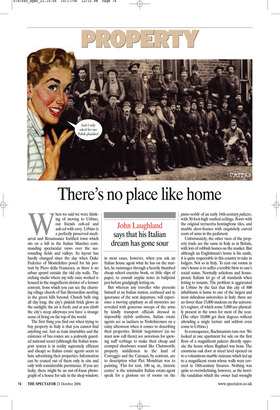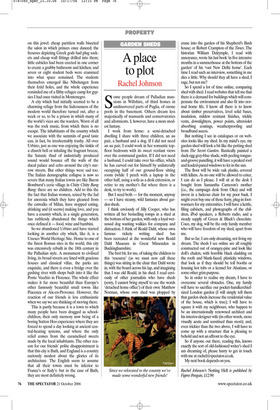There’s no place like home
When we said we were thinking of moving to Urbino, our friends ooh-ed and aah-ed with envy. Urbino is a perfectly preserved mediaeval and Renaissance fortified town which sits on a hill in the Italian Marches commanding spectacular views over the surrounding fields and valleys. Its layout has hardly changed since the day when Duke Federico of Montefeltro posed for his portrait by Piero della Francesca, as there is no urban sprawl outside the old city walls. The etching studio where my wife once worked is housed in the magnificent cloister of a former convent, from which you can see the charming village church of San Bernardino nestling in the green hills beyond. Church bells ring all day long; the city’s pinkish brick glows in the sunlight; the air is fresh; and as you climb the city’s steep alleyways you have a strange sense of living on the top of the world.
The first thing you find out when trying to buy property in Italy is that you cannot find anything out. Just as train timetables and the existence of bus routes are a jealously guarded national secret (although the Italian transport system is in reality supremely efficient and cheap) so Italian estate agents seem to hate advertising their properties. Information can be coaxed out of them only in situ and only with considerable persistence. If you are lucky, there might be an out-of-focus photograph of a house for sale in the shop window; in most cases, however, when you ask an Italian house agent what he has on the market, he rummages through a heavily thumbed cheap school exercise book, or little slips of paper, to consult cryptic notes in ballpoint pen before grudgingly letting on.
But whereas any traveller who presents himself at an Italian station, confused and in ignorance of the next departure, will experience a moving epiphany as all mysteries are revealed with generous sweeps of the arms by kindly transport officials dressed in impossibly stylish uniforms, Italian estate agents are as taciturn as Yorkshiremen on a rainy afternoon when it comes to describing their properties. British ‘negotiators’ (as we must now call them) are notorious for spewing naff verbiage to make their cheap and cramped shoeboxes sound like Chatsworth; property middlemen in the land of Correggio and the Carracci, by contrast, are to description what Piet Mondrian was to painting. ‘Flat for rent, 100 sq. m., historic centre’ is the minimalist Italian estate-agent speak for a glorious set of rooms on the piano nobile of an early 16th-century palazzo, with 30-foot-high vaulted ceilings, floors with the original terracotta herringbone tiles, and marble door-frames with exquisitely carved coats of arms in the pediment.
Unfortunately, the other vices of the property trade are the same in Italy as in Britain, with lots of rubbish homes on the market. But although an Englishman’s home is his castle, it is quite respectable in this country to take in lodgers. Not so in Italy. To rent out rooms in one’s house is to suffer a terrible blow to one’s social status. Normally solicitous and houseproud, Italians let go of all standards when letting to tenants. The problem is aggravated in Urbino by the fact that this city of 800 inhabitants is home to one of the largest and most ridiculous universities in Italy: there are no fewer than 15,000 students on the university’s register, of which some 5,000 are physically present in the town for most of the year. (The other 10,000 get their degrees without attending a single lecture and seldom even come to Urbino.) In consequence, Rachmanism runs riot. We looked at one apartment for sale on the first floor of a magnificent palazzo directly opposite the house where Raphael was born. The enormous oak door at street level opened on to a voluminous marble staircase which led up to a magnificent room whose walls were covered in 18th-century frescoes. Nothing was quite so overwhelming, however, as the horrible vandalism which the owner had wrought on this jewel: cheap partition walls bisected the salon in which princes once danced; the frescoes depicting Greek gods had plug sockets and cheap wall fittings drilled into them; little cubicles had been erected in one corner to create a grubby bathroom and kitchen; and seven or eight student beds were crammed into what space remained. The students themselves emerged like Nibelungen from their fetid holes, and the whole experience reminded me of a filthy refugee camp for gypsies I had once visited in Montenegro.
A city which had initially seemed to be a charming refuge from the hideousness of the modern world therefore turned out, after a week or so, to be a prison in which many of the world’s vices are the warders. Worst of all was the rock music, from which there is no escape. The inhabitants of the country which we associate with the summits of good taste can, in fact, be irredeemably trashy. All over Urbino, just as one was enjoying the tinkle of a church bell or inhaling the fragrant breeze, the Satanic thud of industrially produced sound would bounce off the walls of the ducal palace and echo around the city’s narrow streets. But other things were sad too. The Italian demographic collapse is now so severe that many Italian towns are like Baron Bomburst’s eerie village in Chitty Chitty Bang Bang: there are no children. Add to this the the fact that Italian women, seized by the fad for anorexia which they have gleaned from the catwalks of Milan, have stopped eating, drinking and (it seems) making love, and you have a country which, in a single generation, has ruthlessly abandoned the things which once defined it — food, wine and bambini.
So we abandoned Urbino and have started looking in another city which, like it, is a Unesco World Heritage Site. Home to one of the finest Roman sites in the world, this city was extensively rebuilt in the 18th century in the Palladian style. A monument to civilised living, its broad streets are lined with gracious houses and classical villas, the parks are exquisite, and there is even a bridge over the gushing river with shops built into it like the Ponte Vecchio in Florence. The whole effect makes it far more beautiful than Europe’s other famously beautiful small towns like Piacenza or Aix-en-Provence. However, the reaction of our friends is less enthusiastic when we say we are thinking of moving there.
This is partly because it is a town to which many people have been dragged as schoolchildren, their only memory now being of a boring Sutton Hoo experience where they are forced to spend a day looking at ancient central-heating systems, and where the only relief comes from the caramelised sweets made by the local inhabitants. The other reason for our friends’ polite disappointment is that this city is Bath, and England is a country curiously modest about the glories of its architecture. The English seem to assume that all their towns must be inferior to France’s or Italy’s: but in the case of Bath, they are most definitely wrong.



































































































 Previous page
Previous page